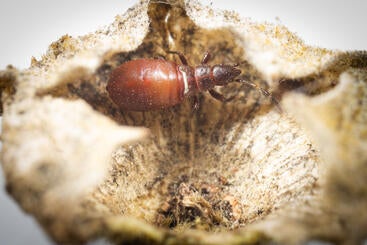Table of Contents
Overview
Cotton Seed Bug Biology
Controlling Cotton Seed Bug
References Cited
Biology and Management of Cotton Seed Bug, Oxycarenus hyalinipennis (Hemiptera: Oxycarenidae)
Overview
Native to Africa, cotton seed bug (CSB), Oxycarenus hyalinipennis (Hemiptera: Oxycarenidae) (Fig. 1), has exhibited high invasion potential having successfully invaded Asia, Europe, the Middle East, and South America (USDA 2021). This pest established in the Caribbean in 1991, and established populations were detected in the Florida Keys in 2010 and were subsequently eradicated by 2014 (USDA 2021). In California, this pest was first detected in urban areas in Los Angeles County in 2019, and by 2021, CDFA confirmed finds in urban areas of Riverside, Orange, and San Diego Counties. At this time there have been no confirmed finds of CSB in commercial cotton production areas of California or other cotton growing areas in the US. CSB populations in urban areas threaten commercial cotton production areas in California and other areas in the US as it is likely that this pest will be moved inadvertently from invasion bridgeheads in residential areas into new locations, most likely urban zones, from where they can infiltrate cotton growing acreage. This is a scenario that California has repeatedly observed with invasive pests where populations establish first in urban areas from where they build up and threaten agricultural production areas (e.g., Asian citrus psyllid, brown marmorated stink bug, and South American palm weevil).
Photo credit: Mike Lewis, UC Riverside.
As its common name suggests, CSB is a notorious pest of cotton, Gossypium hirsutum (Malvales: Malvaceae), and this bug poses a significant new threat to California cotton growers. CSB nymphs can only develop to adults by feeding on seeds of plants in the plant order Malvales. In addition to cotton, known reproductive host species include okra, hibiscus, and weedy invasive Malva spp. (e.g., cheese weed). With respect to cotton, feeding damage by adult and nymphal CSB to cotton seeds can cause weight loss in cotton seed (up to 15%), decrease seed germination rates (up to 88%), and a reduction in oil seed content. High density CSB populations at time of harvest can cause cotton fibers to become stained during ginning which results in decreased value (USDA 2010). Damage to cotton seeds by CSB is enhanced by insect feeding damage to cotton bolls as holes facilitate easier access to seeds. CSB has been found feeding on seeds of native California mallows, and this pest may suppress the production of viable seeds for a variety of federally threatened or endangered plants in the Malvales (e.g., species in the genera Abutilon, Hibiscus, and Gossypium) (USDA 2010 [this reference provides a very good summary table {Table 2-2} of plant species in the Malvales reported to be hosts for CSB]).
The potential economic impact of CSB on the California cotton industry is significant. In 2020, the California cotton industry was valued at $269 million per year and the crop is planted on 181,000 acres primarily in five counties, Kings, Tulare, Merced, Fresno, and Riverside Counties. Fortunately, CDFA field surveys, with support from the California Cotton Board, have failed to detect CSB in major cotton growing areas of Glenn, Colusa, Sutter, Merced, Fresno, Kings, Tulare, Riverside and Imperial Counties. CSB has not been detected in Arizona, Arkansas, Georgia, Texas, or North Carolina where cotton is also grown.
Cotton Seed Bug Biology
Photo credit: Mike Lewis, UC Riverside.
Adult CSB are small, about 4-5mm (0.16-0.20 inches) in length (Fig. 2) and are brown to black in color. Females can lay up to 110 eggs either singly or in groups and eggs can hatch in about 4 – 8 days (USDA 2021). Eggs tend to be yellow colored when laid and turn reddish-orange as they mature. Females lay eggs inside cotton bolls or seed pods of other suitable hosts in the Malvales. Once eggs hatch, nymphs, which tend to be reddish in color (Fig. 3), aggregate on host seeds in groups referred to as “feeding swarms.” There are five nymphal instars, and depending on host availability and temperature, development from egg to adult can occur in about a month and in some areas, four to seven generations per year may be possible. USDA risk maps suggest CSB could survive in plant hardiness zones 8-11 (USDA 2010). To feed, nymphs and adult CSB use their needle like mouthparts to pierce host materials (e.g., seeds), inject saliva, and then ingest the liquefied food. Piercing-sucking feeding by CSB leaves necrotic damage, which may be visible as brown spotting. Nymphs and adults readily drink water which may be taken as dew droplets on leaves, or in lab colonies, from water-moistened cotton wicks. In the absence of freely available water, moisture can be extracted from leaves or fruit (e.g., apples, apricots, avocados, dates, figs, pear, persimmons, and quince) which can result in feeding damage and contamination with fecal droplets (Halbert and Dobbs 2010; USDA 2010, 2021). Adult CSB can enter diapause over winter when host plant seeds are unavailable. Overwintering CSB exhibit cryptic behaviors such as hiding in cracks and crevices on tree bark, amongst the roots of grasses, inside seed pods and curled dead leaves, or within human-made structures (USDA 2021). This latter behavior, hiding in human-made structures (e.g., cars, BBQs, picnic tables), may greatly increase the chances of this pest being accidentally moved into new areas where new populations establish long distances from the source population.
Controlling Cotton Seed Bug
Photo credit: Mike Lewis, UC Riverside.
Several control methods are recommended for CSB management. Foremost amongst these are good sanitation practices, which include the removal of overwintering debris (e.g., cotton stalks with bolls) (Fig. 4) and elimination of weedy malvaceous hosts near cotton fields or other areas of concern (USDA 2010; 2021). Seed cotton stored in large compacted modules after harvest should be covered before being ginned to prevent infestation by CSB and processing material through cleaning equipment to remove foreign matter may reduce CSB staining to ginned cotton (USDA 2010). The most commonly employed control method for CSB is insecticide applications. However, effective control may be difficult as CSB may aggregate in areas away from the crop being sprayed, penetration of products into cotton bolls where CSB are feeding may be difficult, and time of day when applications are made could be poorly timed and do not coincide with CSB activity. For example, CSB may be relatively inactive in early morning when conditions for spraying are optimal (USDA 2010). A variety of broad-spectrum contact and systemic insecticides appear to have efficacy against CSB (USDA 2010; 2021). However, a review of the published scientific literature strongly indicates that CSB has a remarkable ability to develop resistance to several classes of insecticides with different modes of action. Effective biological control agents of CSB appear to be either unknown or non-existent and natural enemies associated with this pest appear to be generalist predators such as assassin bugs (i.e., Reduviidae). Should CSB establish in cotton production areas, effective sustainable management programs are likely to be IPM-based and will involve a combination of good sanitation practices, judicial use of carefully-timed applications of effective insecticides with different modes of action that are used in rotation to minimize resistance development, and conservation biological control to maximize contributions of naturally-occurring generalist predators (e.g., lacewing larvae [Chrysoperla spp.] and predatory hemipterans [e.g., Zelus and Nabis spp.]) inhabiting cotton fields.
References Cited
CDFA 2021. California Agricultural Statistics Review 2020-2021.
Dowell, R.V., R.J. Gill, D.R. Jeske, and M.S. Hoddle. 2016. Exotic terrestrial macro-invertebrate invaders in California from 1700 to 2010: An analysis of records. CA Acad. Sci. Series 4 63(3): 63-157.
Halbert, S.E., and T. Dobbs. 2010. Cotton seed bug, Oxycarenus hyalinipennis (Costa): A serious pest of cotton that has become established in the Caribbean basin. Pest Alert, Florida Department of Agriculture and Consumer Services, Division of Plant Industry, FDACS-P-01726.
Hoddle, M.S. and C.D. Hoddle. 2017. Palmageddon: The invasion of California by the South American palm weevil is underway. CAPCA Adviser 20(2): 40-44.
Hoddle, M.S. 2019. Spotted lantern fly is coming – California is getting ready, now! CAPCA Adviser 22(4): 38-41.
Lara, J.R., C. Pickett, B. Grafton-Cardwell, P. Gordon, J. Reger, S. Figuroa, M. Romo, J. Oliva, and M.S. Hoddle. 2018a. Stinky in high numbers: What’s new with brown marmorated stink bug in California? CAPCA Adviser 21(1): 44-48.
Lara J.R., C. Pickett, E. Hannon, L. Gonzalez, S. Figueroa, M. Romo, C. Cabanas, V. Bazurto, V. Strode, K. Briseno, M. Lewis, J. Corso, M. Atkinson, and M.S. Hoddle. 2018b. Trouble comes in pairs: Invasive stink bugs in California. CAPCA Adviser 21(6): 62-72.
Lara J.R., C.H. Pickett, and M.S. Hoddle. 2019. A fortuitous arrival: Key natural enemy of BMSB found in California. CAPCA Adviser 22(5): 52-57.
Milosavljević I., Schall K., Hoddle C., Morgan D., Hoddle M. 2017. Biocontrol program targets Asian citrus psyllid in California’s urban areas. California Agriculture 71(3). 169-177.
USDA 2010. New Pest Response Guidelines – Cotton Seed Bug. 114 pp
USDA 2021. Technical Bulletin – Oxycarenus hyalinipennis (Costa) (Hemiptera: Oxycarenidae), cotton seed bug. 6pp




